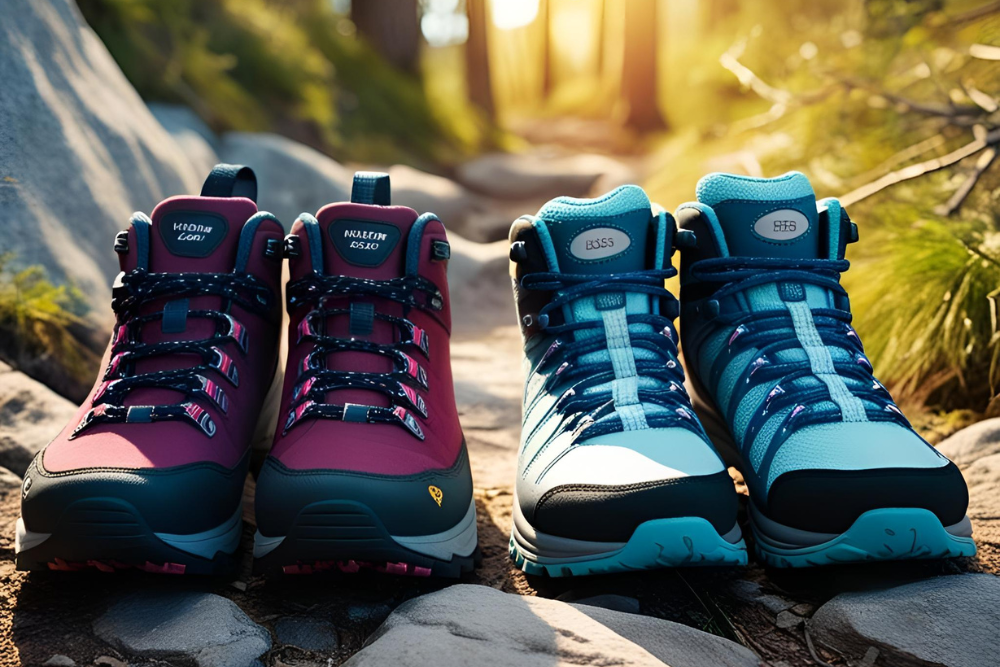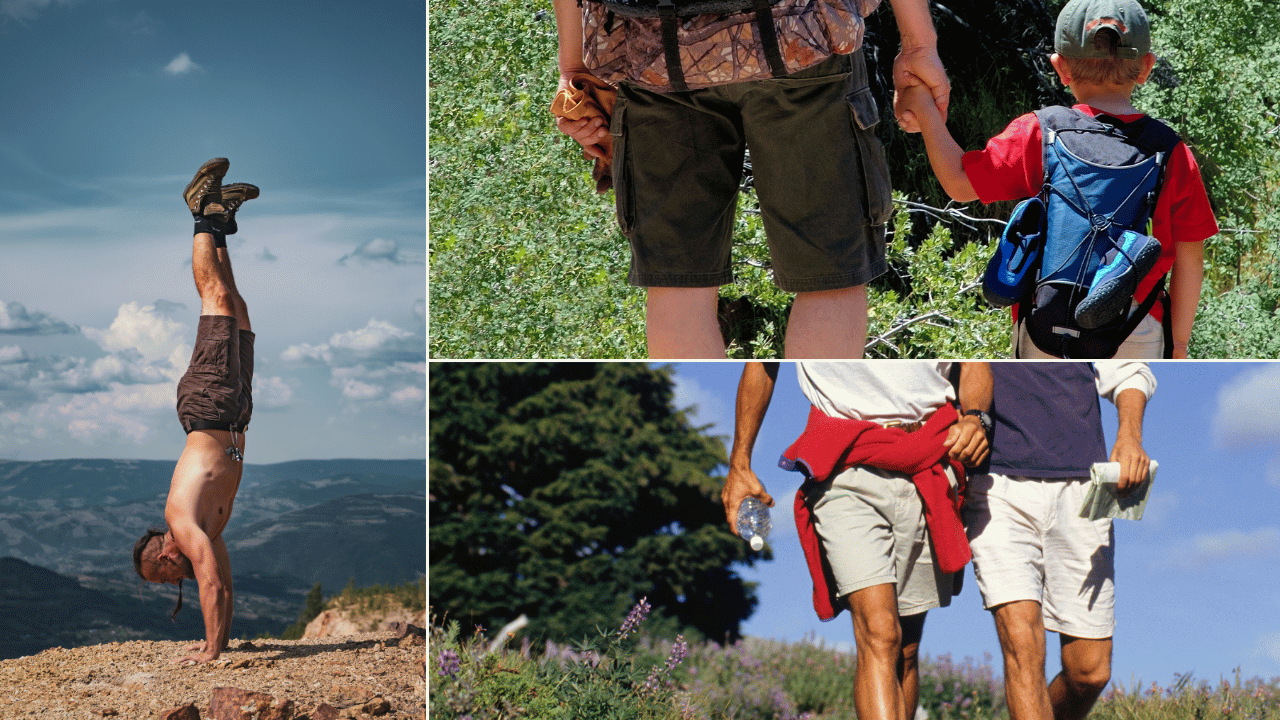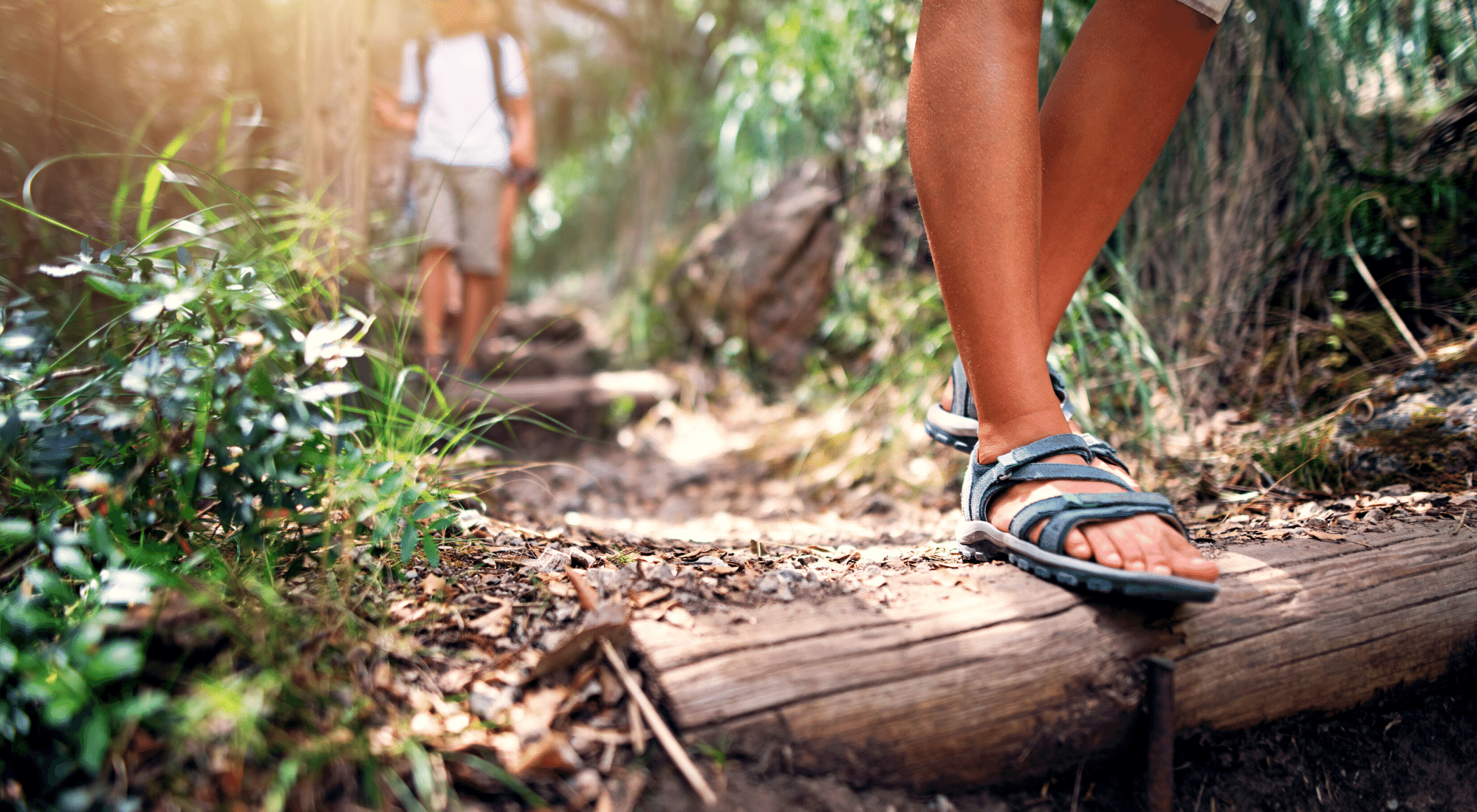🌲 Are Men and Women Hiking Shoes Different? Or just a matter of sole searching? 🥾
When it comes to hiking footwear, understanding the differences between men's and women's shoes can make a significant difference in comfort and performance on the trails.
Journey Fanatics may earn a commission from qualifying purchases, but we promise the prices are still the same for you!
Finding the perfect hiking shoes can feel like a trek in itself. Should you opt for women’s hiking shoes, or are men’s boots the better fit? 🤔 Understanding the distinctions between men’s and women’s hiking footwear is crucial for comfort, performance, and safety on the trails.
A basic hiking shoe offers essential features such as support and grip, which are part of hiking shoe features, and durability, making it suitable for various terrains and addressing both comfort and performance aspects.
For years, hikers have debated whether men’s and women’s hiking shoes are different, or if the variations are just marketing gimmicks. Spoiler alert? The differences are real, and they go far beyond colors and styles. From fit and design to traction, protection, and weight, there are unique factors to consider when choosing hiking boots or shoes tailored to your feet.
Whether you’re preparing for a day hike, planning to conquer technical trails, or simply seeking a supportive pair for longer hikes, selecting the right shoe is key. 🎯 Read on as we take a deep (but fun) look into the world of hiking footwear, giving you everything you need to know to make an informed choice. 🏞️

The Anatomy of Great Hiking Shoes 🔍
When shopping for hiking footwear, you'll encounter a variety of features that cater to different preferences and trail conditions. Here are some key elements to understand:
- Waterproof and Breathable Membrane: Essential for wet weather and damp trails, this feature keeps water out while allowing airflow, so your feet stay dry and cozy.
- Vibram Outsole: Perfect for gripping uneven surfaces such as rocks and tree roots, ensuring excellent traction no matter where you step.
- Toe Cap & Wide Toe Box: Protects against sharp obstacles like scree and roots while giving toes plenty of room to move, reducing the risk of blisters or hot spots.
- Firm Midsole with EVA Foam: Offers superior underfoot support and stability for those packing heavy gear or hiking technical trails.
- Mesh Upper: Enhances airflow, making it ideal for hot weather hikes while minimizing sweat and overheating.
- Ankle Protection: Found in most traditional hiking boots, this added coverage supports the ankle, giving you extra stability on uneven ground.
- Recycled Materials: A growing trend among eco-conscious brands, this encourages sustainable shoe construction without compromising performance.
Ready to Hit the Trails? 🌟🌄
Hiking is a beloved outdoor activity that offers a perfect blend of physical challenge and a chance to connect with nature. Whether you’re a seasoned hiker or just starting, having the right gear is essential, and nothing is more critical than a good pair of hiking boots or shoes. These aren’t just any shoes; they’re designed to provide the comfort, support, and protection your feet, ankles, and legs need while navigating various terrains.
For women, in particular, finding the right pair of hiking boots can make all the difference. Women’s hiking boots are crafted to accommodate the unique shape and size of women’s feet, ensuring a snug fit and optimal performance on the trails. So, let’s dive into why these boots are so important and what key features to look for when selecting your perfect pair. 🌟

Why Do Men's and Women's Hiking Shoes Differ? 👟
At first glance, it’s easy to assume that hiking footwear is unisex. After all, hiking is hiking, right? Not so fast. Men’s and women’s hiking shoes have key differences that address biomechanics, foot shape, and gender-specific preferences. Men's and women's feet are shaped differently, which influences the design and fit of hiking shoes, such as the toe box width and heel fit.
1. Fit and Foot Shape
Women tend to have narrower feet, especially toward the heel, whereas men generally have wider feet across the toe box and forefoot. This variance means a pair of men’s hiking boots could feel clunky or loose on narrow feet, causing instability on the trail. The female foot, characterized by its narrower structure compared to the male foot, requires careful selection of footwear based on individual foot shapes rather than strictly adhering to gender labels.
- Heel Cup Design: Women’s hiking shoes often include a snug heel cup for a better grip around the heel, reducing slippage on uneven ground.
- Arch Support: Women tend to have higher arches, so manufacturers often include enhanced arch support in their hiking shoes, ensuring their feet stay properly aligned.
- Wide Feet or High Volume Feet: Look for models with wide toe boxes and a more spacious fit, such as those by Merrell Moab or Salomon.
- Narrow Feet or Low Volume Feet: A snug, customizable fit with options for adjusting laces or adding inserts helps achieve the perfect feel for particular foot shapes.
- Very Wide Feet: Men's shoes are often a better choice for individuals needing extra room, but some brands like Vasque offer great unisex options.
- Foot Pain or Prone to Sore Feet: Shoes with plush EVA foam, added cushioning, and underfoot support can help reduce discomfort during long hikes. Be mindful of rigid materials and break in your shoes before hitting demanding trails.
- Hot Spots and Blisters: Extra padding around sensitive areas and seamless mesh uppers can prevent irritation during extended miles.
Pro Tip: If you’re a woman with wider feet, you may find men’s hiking footwear more comfortable. Likewise, men with narrow feet might prefer a snug women’s version. Trying on both options can help you figure out what works best for your foot shape.
2. Weight and Materials
Women tend to weigh less than men, which means women’s hiking shoes are typically engineered with lighter materials to eliminate unnecessary additional weight. Selecting lightweight shoes that ensure all day comfort is crucial for lighter outings with minimal gear, as they provide the necessary comfort and efficiency. When tackling long distances or ascending steep inclines, even an ounce or two of extra weight can make a big difference.
Meanwhile, men’s boots are often heavier and more rugged to suit technical trails and heavy backpacks. They’re built for durability, offering thicker soles and sturdier materials for extra support and stabilization under pressure.
Common Weight Considerations:
- Trail Running Shoes: Perfect for hikers who want a lighter weight option with speed and flexibility. Great for less rugged terrain. Lightweight hiking shoes are ideal for dry weather, offering excellent breathability and comfort to keep your feet dry and cool.
If you’re looking for great running shoes, check out this article: 8 Best Cushioned Running Shoes for a Comfortable Run. Discover the best options for reducing joint impact, improving recovery, and adding comfort to your runs—perfect for athletes and beginners!
- Hiking Boots: Better suited for those carrying substantial loads or facing slippery rocks and sharp rocks on more rugged trails.
3. Cushioning and Support
Hiking shoes for women often feature extra cushioning around the heel and forefoot areas to provide essential foot support, which is especially beneficial for those with a high arch . This added support not only improves comfort but also absorbs more shock for women’s feet, which tend to experience different pressure points than men’s.
Men’s hiking shoes, by contrast, prioritize ankle support and sturdiness. Lighter cushioning is offset by materials designed for fantastic traction, even on uneven and slippery terrain.
4. Waterproofing
Both genders benefit from waterproof hiking shoes, especially in wet conditions. A good grip is crucial in these conditions to ensure reliable traction and stability, allowing hikers to navigate steep trails and muddy surfaces with confidence. However, women’s hiking footwear often pays more attention to breathability and moisture-wicking technology, while men’s hiking footwear may feature deeper lugs for enhanced traction . Materials like Gore-Tex are commonly used to balance water resistance with effective ventilation, making them equally suitable for day hiking in unpredictable weather or trudging through muddy trails.
Men’s waterproof version, while equally effective, tend to focus on rugged durability and are often lined with layers tailored to fight extreme weather conditions over longer hikes.
5. Traction and Tread
Traction plays a crucial role in keeping hikers grounded, literally. Men’s hiking boots often feature deeper, more aggressive tread patterns for excellent traction on larger surface areas. Meanwhile, women’s hiking shoes prioritize agility and lighter frame support, offering a finer tread design with deeper lugs to ensure better grip without requiring extra force from the wearer.
This difference especially stands out in trail runners and walking shoes, which cater to cross-functional outdoor activities.
6. Aesthetics and Design
Visual appeal matters, even when it comes to hiking gear. Women’s hiking shoes often feature a more diverse range of color schemes and designs to cater to individual tastes. Women's shoes are typically designed with a narrower fit at the ankle and a wider toe area to accommodate common foot shape variations. Men’s footwear often sticks to neutral tones like black, gray, or brown. But whether you’re into vibrant hues or rugged classics, it’s always better to prioritize function over fashion.

Women’s Hiking Boots 👢
When it comes to hiking boots, one size definitely does not fit all, especially for women. Women’s feet tend to be narrower and more slender than men’s, with higher arches and narrower heels. This means that women’s hiking boots are designed with these specific characteristics in mind. You’ll find that women’s hiking boots often feature narrower toe boxes and shorter lengths to provide a more precise fit, which is particularly important for those with a narrow foot.
Additionally, these boots are typically lighter in weight, with more flexible soles and lower ankle collars, allowing for greater mobility and comfort on the trails. This thoughtful design makes it easier for women to tackle challenging terrain without sacrificing comfort or stability. So, if you’re a woman looking to conquer the great outdoors, investing in a pair of women’s hiking boots or a comfortable hiking shoe tailored to your feet can make your hiking experience incredibly comfortable and enjoyable. 🌸
Choosing the Right Hiking Shoes for Various Trail Types 🏔️
Your choice of hiking footwear shouldn’t just depend on fit; trail conditions and your activity also play a major role. Choosing the right hiking shoes for technical terrain is crucial, as these challenging and varied trail conditions require superior traction and stability. Here’s a breakdown of the best options for popular hiking terrains:
1. Casual Day Hikes
For scenic nature walks or easy trails, walking shoes, trail runners, or breathable hiking shoes work perfectly. These shoes are lightweight, breathable, and provide good traction on dirt paths.
It's important to try on both men's shoes and women's shoes to find the best fit for casual day hikes, as comfort and fit should take precedence over gender labels.
- Summer Hikes or Hot Weather: Opt for low-cut hiking boots or lightweight shoes with mesh panels for better ventilation, ensuring comfort when the temperatures rise. These are ideal for shorter hikes or climbing in warm conditions.
- Snow or Cold Weather: For winter conditions, insulated boots with thicker fabric, strong heel protection, and fabric that retains heat will keep your feet warm and secure.
2. Terrain with Slippery Rocks and Mud
Opt for hiking boots that offer stability with great traction and excellent waterproofing. Men’s and women’s hiking shoes designed for wet trails incorporate grippy outsoles and moisture-resistant linings. Waterproof hiking boots with moisture-wicking linings, like those using Gore-Tex, prevent water intrusion while maintaining breathability. This is especially helpful for hiking in the Pacific Northwest or crossing streams.
3. Rugged, Rocky Trails
Tackling technical trails? Consider a hiking boot with reinforced materials and ankle collars for stability. Shoes with a rigid build, Vibram outsoles, and underfoot protection shield your feet from sharp rocks and abrasions. Look for models with a durable toe cap and midsole stiffness for stability. The key is ensuring the shoe fits like a glove while providing ample support for heavy backpacks.
4. Long-Distance Hikes
Hikers covering long distances should prioritize footwear with more support, extra cushioning, and a snug fit that doesn’t compromise toe space. A waterproof shoe is beneficial for hikes where weather conditions fluctuate. Many hikers swear by two pairs of hiking socks during these longer treks to minimize blisters. If you’re encountering tree roots or uneven surfaces, a shoe with a supportive midsole, lightweight ankle protection, and a Vibram outsole guarantees a stable, planted feel.
Fine-Tuning the Fit 🔧
Getting the perfect fit for your hiking boots is crucial for a comfortable and enjoyable hiking experience. Women’s hiking boots come in a variety of sizes and widths, so it’s essential to try on several pairs to find the right fit. When you’re trying on hiking boots, make sure to wear the same type of socks you plan to use while hiking, and lace them up securely. Take a walk around the store or do a few laps around the block to ensure the boots feel comfortable and supportive.
It’s also important to consider the type of hiking you’ll be doing and the terrain you’ll be navigating. For instance, if you’re planning to hike in wet or muddy conditions, look for boots with a waterproof membrane and a more aggressive tread pattern. By fine-tuning the fit and features of your hiking boots, you can ensure that your hiking experience is both comfortable and enjoyable. Remember, the right pair of hiking boots can make all the difference on the trail. 🌟
Common Mistakes When Choosing Hiking Footwear
Picking the wrong footwear is one of the fastest ways to ruin a hike. Avoid these common slip-ups:
- Ignoring Your Foot Shape: Whether dealing with high arches, wide feet, or narrow heels, failing to account for your unique needs could result in pain and poor performance. Additionally, consider the differences in foot structure and shoe size between men and women to ensure a proper fit.
- Wrong Socks: Wearing thin or unsuitable socks may cause friction, blisters, or lack of warmth on cold trails.
- Choosing a Size Too Small: Always leave a little extra room; feet swell over long hikes.
- Focusing Solely on Style: While aesthetics are important, prioritize functionality for your trail type and comfort.
Tips for Maintaining Your Hiking Shoes 🛠️
Once you’ve found the perfect pair of hiking shoes, proper care can prolong their lifespan. Here’s how to keep your boots trail-ready:
- Clean Regularly: Use a soft brush to remove mud and debris, paying special attention to the tread.
- Dry Thoroughly: Avoid drying shoes in direct sunlight or high heat, as this can weaken materials. Instead, remove insoles and stuff shoes with newspaper to absorb moisture.
- Reapply Waterproofing: Periodically treat your hiking footwear with waterproof sprays or conditioners to maintain water resistance.
- Replace Insoles: Over time, insoles can lose support. Swap them out for high-quality replacements designed for arch support and stability.
- Maintain the Lacing System: Ensure your lacing system is properly adjusted to secure the heel and minimize movement. This is crucial for avoiding blisters and ensuring comfort during long hikes on uneven terrain.
The Bottom Line 🎯
The debate over are men and women hiking shoes different has a clear answer. Yes, they’re different—but choose the pair that feels best for your feet, and if you're unsure, you might want to find men's shoes as an option. Whether you’re tackling slippery rocks or embarking on a weekend day hike, your adventure will only be as fun and safe as the footwear you lace up. Numerous outdoor brands offer quality men’s and women’s hiking shoes, including Salomon, Merrell, and Keen, making it easy to find the best budget hiking shoe for your next adventure. Noticeable differences between men's and women's hiking boots include the distinct shape and structure designed to accommodate the unique contours of women's feet, ensuring optimal comfort and performance.
Remember, the right hiking shoes or boots are an investment in your comfort and safety. Pick wisely, care for them diligently, and hit the trails confidently. Lace up, step outside, and enjoy the beauty of nature, one trail at a time. 🌿
Make sure to stay hydrated on your adventures; discover the best hiking water bottles tailored for every type of hiker.
Happy hiking! 🥾





